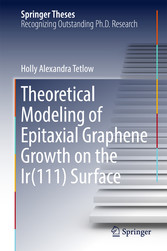Suchen und Finden
Service
Theoretical Modeling of Epitaxial Graphene Growth on the Ir(111) Surface
Holly Alexandra Tetlow
Verlag Springer-Verlag, 2017
ISBN 9783319659725 , 192 Seiten
Format PDF, OL
Kopierschutz Wasserzeichen
Geräte
Supervisor’s Foreword
6
Abstract
8
Parts of this thesis have been published in the following journal articlesGrowth of epitaxial graphene: Theory and experiment, H. Tetlow, J. Posthuma de Boer, I.J. Ford, D.D. Vvedensky, J. Coraux, L. Kantorovich, Physics Reports, 542 (2014) 195–295.Ethylene decomposition on Ir(111): Initial path to graphene formation, Holly Tetlow, Joel Posthuma de Boer, Ian J. Ford, Dimitri D. Vvedensky, Davide Curcio, Luca Omiciuolo, Silvano Lizzit, Alessandro Baraldi, and Lev Kantorovich, Physical Chemistry Chemical Physics 18 (2016) 27897–27909.A free energy study of carbon clusters on Ir(111): Precursors to graphene growth, H. Tetlow, I. J. Ford, and L. Kantorovich, Journal of Chemical Physics 146 (2017) 044702.Hydrocarbon decomposition kinetics from first principles H. Tetlow, L. Kantorovich, In Progress.
9
Acknowledgements
10
Contents
12
1 Review of Epitaxial Graphene Growth
15
1.1 Epitaxial Graphene Growth
15
1.1.1 Experimental Techniques
16
1.2 The Graphene Growth Process
19
1.2.1 Producing a Carbon Source
19
1.2.2 Forming Carbon Clusters
28
1.2.3 Graphene Formation on Ir(111)
34
1.2.4 Graphene Substrate Interaction
37
1.2.5 Removing Defects
39
References
47
2 Theoretical Modelling Methods
50
2.1 Density Functional Theory
50
2.1.1 Formalism
50
2.1.2 The Exchange-Correlation Functional
52
2.1.3 Van der Waals Forces in DFT
53
2.2 Basis-Sets
55
2.2.1 K-Point Sampling
57
2.3 Pseudopotentials
58
2.4 The Nudged Elastic Band Method
59
2.4.1 Climbing Image NEB
60
2.5 Lattice Dynamics
61
2.5.1 Vibrational Free Energy
63
2.6 Core Level Binding Energies
64
2.7 Kinetics
64
2.7.1 Transition State Theory
65
2.7.2 Rate Equations
67
2.7.3 Kinetic Monte Carlo
68
2.7.4 Lattice-Based kMC
70
2.8 Molecular Dynamics
70
2.8.1 Canonical Ensemble: NVT
71
2.8.2 Langevin Thermostat
73
2.9 Ir(111) Surface Parameterisation
74
2.9.1 Bulk Lattice Constant
75
2.9.2 Ir(111) Surface
76
2.9.3 Plane Wave Cutoff Energy
77
References
78
3 Producing a Source of Carbon: Hydrocarbon Decomposition
80
3.1 Theoretical Method Outline
80
3.2 Decomposition Reaction Scheme
81
3.3 Hydrocarbon Species
82
3.4 Hydrogen
83
3.5 Photoemission Experiments
85
3.5.1 Binding Energy Calculations
86
3.5.2 Interpretation of XPS Data
87
3.6 Reaction Energy Barriers
89
3.7 Rate Equations
92
3.8 Conclusions
97
References
98
4 Hydrocarbon Decomposition: Kinetic Monte Carlo Algorithm
99
4.1 Method
99
4.2 Surface Lattice Grid
101
4.3 Hydrocarbon Species
102
4.4 Reactions
104
4.4.1 Hydrogenation and Dehydrogenation Reactions
105
4.4.2 H2 Desorption Reaction
106
4.4.3 C-C Breaking and C-C Recombination Reactions
107
4.4.4 Isomerisation Reactions
110
4.4.5 Diffusion
111
4.4.6 Product Species Fitting
112
4.5 Time Step Calculation
113
4.6 kMC Efficiency
114
4.7 Conclusions
116
5 Thermal Decomposition in Graphene Growth: Kinetic Monte Carlo Results
117
5.1 Temperature Ramping Programmed Growth
118
5.1.1 kMC Results
118
5.1.2 Comparison with Experimental Results
120
5.1.3 Energy Barrier Tuning
122
5.1.4 Comparison with Rate Equations
125
5.2 Fixed Temperature Programmed Growth (kMC)
126
5.3 Ethylene Decomposition on Pt(111)
128
5.3.1 Energy Barriers
129
5.3.2 kMC Results
130
5.4 Chemical Vapour Deposition
131
5.4.1 Ethylene
132
5.4.2 Methane
133
5.5 Conclusions
135
References
137
6 Beginnings of Growth: Carbon Cluster Nucleation
138
6.1 Classical Nucleation Theory
138
6.1.1 Derivation of ??(N)
139
6.2 Carbon Clusters
142
6.2.1 Rotational Multiplicity
142
6.3 Zero-Temperature Formation Energy
143
6.4 Temperature Dependence of the Work of Formation
145
6.5 Vibrational Free Energy Dependence on Cluster Type
147
6.6 Cluster Isomerisation During Growth
148
6.7 Conclusions
150
References
152
7 Removing Defects: Healing Single Vacancy Defects
153
7.1 Theoretical Method Outline
153
7.2 Single Vacancy Defects
154
7.3 Langevin Thermostat
154
7.3.1 Computation of Phonon DOS
155
7.3.2 Choice of the Damping Parameter
157
7.4 Molecular Dynamics Simulations of Defect Healing
158
7.4.1 System Configuration
158
7.4.2 Initialisation
158
7.4.3 Ethylene Molecule Deposition
159
7.4.4 Ethylene Molecule Starting Position
159
7.4.5 Simulation Results
162
7.4.6 Conclusions from the MD Simulations
166
7.4.7 Final States
167
7.5 NEB Healing of the Single Vacancy Defect
168
7.6 Conclusions
169
References
170
8 Final Remarks
171
8.1 Conclusions
171
8.2 Limitations and Further Work
174
References
176
Appendix A Hydrocarbon Decomposition
177
A.1 Lowest Energy Hydrocarbon Geometries
177
A.1.1 NEB Reaction Profiles
178
A.1.2 Core Level Binding Energy Calculations
182
A.1.3 Convergence of Energy Barriers with Number of Layers
182
A.1.4 H2 Desorption
184
A.1.5 Pre-exponential Factors
184
A.1.6 Vibrational Frequency Calculations and Coverage Effects
185
A.1.7 Rate Equations
186
Appendix B Carbon Clusters and Their Formation Energy at T=0
189
Reference
192
Service
Shop



